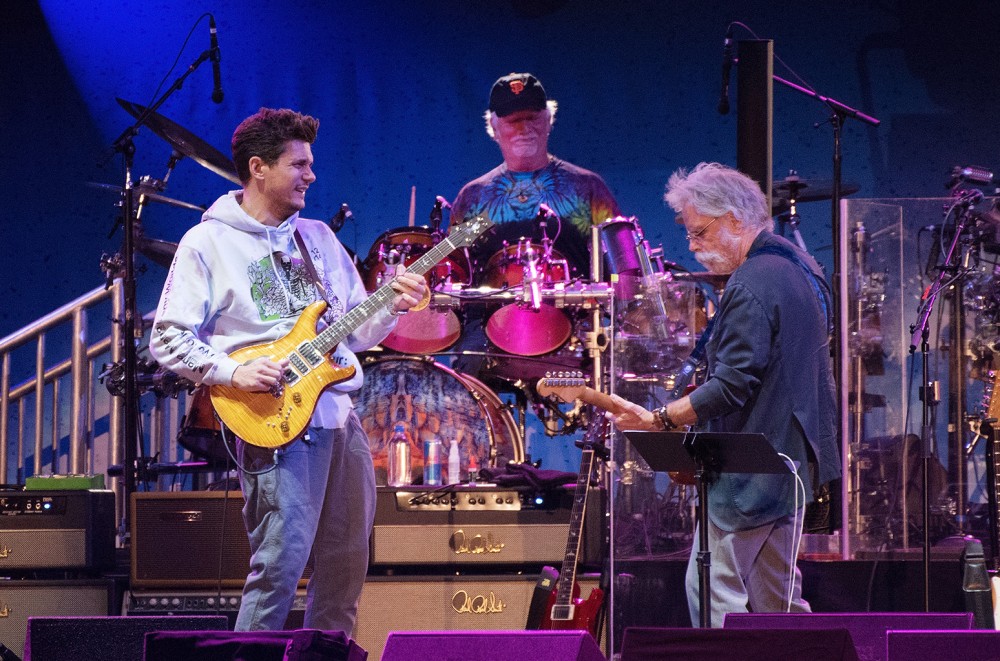
At the stroke of midnight, a seven-foot tall Father Time in a wizard-white beard, a resplendent crown of roses, and a satin muumuu rang in the start of the new decade. It was Basketball Hall of Famer Bill Walton, the Grateful Dead’s most iconic fan, who passed on the burden of the next 365 days to Baby New Year — played by Wavy Gravy, the 83-year old comic and freelance clown, clad in a psychedelic loincloth, a sash, and little else.
A skull and roses bi-plane with the pair of skeletons sitting on its wings languidly sailed above the 18,000 tie-died revelers. It was piloted by Trixie Garcia (daughter of Jerry) and Sunshine Kesey (daughter of legendary '60s author Ken), who tossed rose petals onto both the crowd and a Roaring Twenties chorus line of Flapper Girls dancing the Charleston on the stage of San Francisco’s Chase Center. John Mayer took photos as if he were a fan, and not the band’s lead guitarist, tasked with the impossible role of reanimating the spirit of Jerry Garcia. Then a few thousand rainbow-colored balloons descended from the rafters to the floral strains of “Sugar Magnolia.”
It was New Year’s Eve at Dead & Company’s final show of a four-night “Fun Run” mini-tour that included two stellar performances the previous week at The Forum in Los Angeles. In line with storied tradition, the trip remained long and strange.
Of course, it wasn’t 1978 going into 1979, when the Dead closed out San Francisco’s famed Winterland Arena with an eight-hour concert that included a dawn breakfast of ham and eggs and champagne, the Blues Brothers, the New Riders of the Purple Sage, Bill Murray, a rendition of “Dark Star” that has long descended into myth, and so many psychedelics and stimulants that no one involved would remember it had they not filmed the festivities. Nor was it New Year’s Eve '87-'88 at the Oakland Coliseum, which was broadcast live on Pay-Per-View and included a skit where drummer Mickey Hart portrayed Star Trek’s Spock deploying a Vulcan mind meld to reveals the thoughts of Jerry Garcia — who happened to be dressed as Santa Claus.
But everything is relative. To even see this iteration of the Dead feels like a St. Stephen-induced miracle. At 72, Bob Weir’s voice retains the ragged weariness of a spiritual vagabond and the ageless cowboy fortitude of Jack Palance performing one-armed pushups at the Oscars. His rhythm guitar playing remains rugged and steadier than when he first discovered Garcia playing the banjo alone at a Palo Alto music store on New Year’s Eve, 1963. On that night over a half century ago, the pair conducted an impromptu jam session that forged a telepathic musical connection that lasted until Garcia’s fatal heart attack in the summer of 1995.
The other original members of the Grateful Dead are drummers Mickey Hart and Bill Kreutzmann, “the rhythm devils,” who have spent the last half century in a fearless Apache dance of weird experimentation and deep meditative groove. Today, they offer an authenticity and original pulse. Jeff Chimenti deftly handles keyboards — as he has in nearly all Dead-related endeavors since 1997 — while bassist Oteil Burbridge operates as a secret weapon of sorts, offering abyssal funk licks and soulful vocals, most notably on the setlist linchpin “Fire on the Mountain.”
The wild card, of course, has always been John Mayer, the polarizing blues guitarist and occasional pop singer-songwriter, who deserves yeoman’s credit for partially submerging his own solo identity in service of the group. Reverently and impressively channeling Garcia’s crystal liquid guitar solos, Mayer graciously understands the band’s traditional taxonomy has been reversed. Even if the band was famously leaderless, Garcia offered a transverberating spiritual center. In his quarter century absence, Weir has transformed himself from the titanium backbone of the band to the inheritor of Garcia’s ragged mystic spirit.
You can see it most starkly when he belts out songs like “Loser” and “Sugaree,” which previously belonged to his late collaborator, but now seem to exist in a timeless communal ownership between band and fans. With most of the baby boomer rock gods dead or approaching retirement, Weir has retained a visceral intensity. His only remaining active peers left are Mick Jagger and Keith Richards, Neil Young, and Robert Plant whenever he decides to gig.
All these things amount to just a few of the reasons why, after 54 years extant, the Dead remain arguably more popular than ever. Since forming four years ago, Dead and Company have grossed well over $200 million and sold more than 2 million tickets. Tie dye now regularly appears in the pages of GQ, and indie artists like Bon Iver and Ezra Koenig of Vampire Weekend cite them as musical touchstones. It’s a tremendous reversal of fortune for a band who with the exception of a few albums (American Beauty and Workingman’s Dead) were largely anathema to critics. Deadhead hippies were often on the enemies list of punks and indie snobs, but now, the Dead — once synonymous with patchouli and whippets — are arguably more relevant than anyone in the lionized Woodstock generation.
To fully appreciate everything requires a recognition of the cognitive dissonance inherent in seeing a Grateful Dead show on the verge of the third decade of the 21st century. The once-lawless drug-and-merch bacchanalia that was Shakedown Street has been reduced to a sad dwindling vortex. Outside of the Chase Center, vendors hawk patches, pins, and hats of dancing bears and skull and roses, and deified portraits of Garcia. But due to a lack of space or possibly a desire to include them, police and organizers had afforded the carnival a narrow strip to co-exist — placing them so close to San Francisco Bay that a strong wind could seemingly have toppled the entire bootleg enterprise.
There was also the clear understanding that this is not the Fillmore in 1972. To get close to Bill Walton in the main pit could easily run you a thousand dollars a ticket, meaning that the crowd was largely comprised of well-heeled Bay Area hippies-turned-tech-entrepreneurs and their children. The band’s unvarnished Americana spirituals were sung just underneath corporate suites sponsored by Verizon and Adobe, Pepsi and Google Cloud. For every green-dreadlocked and nose-ringed disciple too young to have seen the oracular Garcia in terrestrial form, there seemed to be several more who had made millions off Oracle stock.
But what was abundantly clear throughout the New Year’s Eve performance and the three shows that preceded it, was the ability of the songs themselves to transcend the absence of Garcia and bassist Phil Lesh (who left after the conclusion of their Fare Thee Well run in 2015). Dead and Company have developed their own identity while remaining faithful to the original band’s creative restlessness and interstellar flights.
To hear Weir howl the Wilson Pickett cover “In the Midnight Hour” or the Mardi Gras anthem “Iko Iko” was to watch the decades momentarily disintegrate, to witness all the baggage of the past dissolving as though this were the first time Weir had ever sung them. It was to hear “Tennessee Jed” and “Sugaree,” and “Scarlet Begonias” unfurling like gilded scrolls complete with their own parchment lineages. Every fan in the room ecstatic and swaying, the lyrics long tattooed in their memory, passing joints to strangers like they’d done since it was deeply illegal.
For three hours it was a memory of a better, weirder world. And just often enough, the band would hit an infinity lick — tap into the rare axis mundi ability to make it feel like all the lines and angles were converging on this point. For a riff or sometimes even an entire song, this felt like the only place to be in the entire world — so much that it almost felt real. And even if you knew this was just the next best thing, you could pretend otherwise if you silenced your doubts and squinted. The only real downside was the risk of injury from the toxic rain of glowsticks hurled from the level above.
By the time it ended, it was well past midnight. The crowd and band had reiterated their long-standing compact that their love would never fade away. Then Dead and Company played “Touch of Grey,” a tribute to the forever-mourned Garcia, the tradition sustaining itself for another unlikely season. And just like that, the skeletons danced one more time.
Set 1:
In the Midnight Hour
Big Railroad Blues
Iko Iko
Mr. Charlie
Loser
Tennessee Jed
Sugaree
New Speedway Boogie
Set 2:
Help on the Way
Slipknot!
Franklin's Tower
Estimated Prophet
Eyes of the World
Drums
Space
Milestones
Standing on the Moon
Not Fade Away
Set 3:
Sugar Magnolia
Uncle John's Band
Scarlet Begonias
Fire on the Mountain
Sunshine Daydream
Encore:
Touch of Grey


 103
103